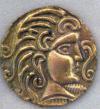Planets around Other Stars Are Like Peas in a Pod

Thanks in large part to the NASA Kepler Telescope, launched in 2009, many thousands of exoplanets are now known. This large sample allows researchers to not only study individual systems, but also to draw conclusions on planetary systems in general. Dr. Weiss is part of the California Kepler Survey team, which used the W. M. Keck Observatory on Maunakea in Hawaii, to obtain high-resolution spectra of 1305 stars hosting 2025 transiting planets originally discovered by Kepler. From these spectra, they measured precise sizes of the stars and their planets.
In this new analysis led by Weiss and published in The Astronomical Journal, the team focused on 909 planets belonging to 355 multi-planet systems. These planets are mostly located between 1,000 and 4,000 light-years away from Earth. Using a statistical analysis, the team found two surprising patterns. They found that exoplanets tend to be the same sizes as their neighbors. If one planet is small, the next planet around that same star is very likely to be small as well, and if one planet is big, the next is likely to be big. They also found that planets orbiting the same star tend to have a regular orbital spacing.
“The planets in a system tend to be the same size and regularly spaced, like peas in a pod. These patterns would not occur if the planet sizes or spacings were drawn at random.” explains Weiss.
The similar sizes and orbital spacing of planets have implications for how most planetary systems form. In classic planet formation theory, planets form in the protoplanetary disk that surrounds a newly formed star. The planets might form in compact configurations with similar sizes and a regular orbital spacing, in a manner similar to the newly observed pattern in exoplanetary systems. However, in our solar system, the inner planets have surprisingly large spacing and diverse sizes. Abundant evidence in the solar system suggests that Jupiter and Saturn disrupted our system’s early structure, resulting in the four widely-spaced terrestrial planets we have today. That planets in most systems are still similarly sized and regularly spaced suggests that perhaps they have been mostly undisturbed since their formation.
To test that hypothesis, Weiss is conducting a new study at the Keck Observatory to search for Jupiter analogs around Kepler’s multi-planet systems. The planetary systems studied by Weiss and her team have multiple planets quite close to their star. Because of the limited duration of the Kepler Mission, little is known about what kind of planets, if any, exist at larger orbital distances around these systems. They hope to test how the presence or absence of Jupiter-like planets at large orbital distances relate to patterns in the inner planetary systems.
Regardless of their outer populations, the similarity of planets in the inner regions of extrasolar systems requires an explanation. If the deciding factor for planet sizes can be identified, it might help determine which stars are likely to have terrestrial planets that are suitable for life.
Julie Gazaille
Université de Montréal
The article “The California-Kepler Survey V. Peas in a Pod: Planets in a Kepler Multi-planet System are Similar in Size and Regularly Spaced” is published in The Astronomical Journal. It was funded by the Trottier Family Foundation. In addition to Lauren M. Weiss (Institute for research on exoplanets iREx, Université de Montréal), the team includes Benjamin J. Fulton (Caltech, University of Hawaii), Erik A. Petigura (Caltech), Andrew W. Howard (Caltech), Howard Isaacson (UC Berkeley), Geoffrey W. Marcy (UC Berkeley), Phillip A. Cargile (Harvard), Leslie Hebb (Hobart and William Smith Colleges), Timothy D. Morton (Princeton), Evan Sinukoff (University of Hawaii, Caltech), Ian J. M. Crossfield (University of California, Santa Cruz) and Lea A. Hirsch (Caltech).
Source:
Anyone can join.
Anyone can contribute.
Anyone can become informed about their world.
"United We Stand" Click Here To Create Your Personal Citizen Journalist Account Today, Be Sure To Invite Your Friends.
Before It’s News® is a community of individuals who report on what’s going on around them, from all around the world. Anyone can join. Anyone can contribute. Anyone can become informed about their world. "United We Stand" Click Here To Create Your Personal Citizen Journalist Account Today, Be Sure To Invite Your Friends.
LION'S MANE PRODUCT
Try Our Lion’s Mane WHOLE MIND Nootropic Blend 60 Capsules
Mushrooms are having a moment. One fabulous fungus in particular, lion’s mane, may help improve memory, depression and anxiety symptoms. They are also an excellent source of nutrients that show promise as a therapy for dementia, and other neurodegenerative diseases. If you’re living with anxiety or depression, you may be curious about all the therapy options out there — including the natural ones.Our Lion’s Mane WHOLE MIND Nootropic Blend has been formulated to utilize the potency of Lion’s mane but also include the benefits of four other Highly Beneficial Mushrooms. Synergistically, they work together to Build your health through improving cognitive function and immunity regardless of your age. Our Nootropic not only improves your Cognitive Function and Activates your Immune System, but it benefits growth of Essential Gut Flora, further enhancing your Vitality.
Our Formula includes: Lion’s Mane Mushrooms which Increase Brain Power through nerve growth, lessen anxiety, reduce depression, and improve concentration. Its an excellent adaptogen, promotes sleep and improves immunity. Shiitake Mushrooms which Fight cancer cells and infectious disease, boost the immune system, promotes brain function, and serves as a source of B vitamins. Maitake Mushrooms which regulate blood sugar levels of diabetics, reduce hypertension and boosts the immune system. Reishi Mushrooms which Fight inflammation, liver disease, fatigue, tumor growth and cancer. They Improve skin disorders and soothes digestive problems, stomach ulcers and leaky gut syndrome. Chaga Mushrooms which have anti-aging effects, boost immune function, improve stamina and athletic performance, even act as a natural aphrodisiac, fighting diabetes and improving liver function. Try Our Lion’s Mane WHOLE MIND Nootropic Blend 60 Capsules Today. Be 100% Satisfied or Receive a Full Money Back Guarantee. Order Yours Today by Following This Link.








Remember, it was 50 years ago that astronomers believed that our solar system was the only one in the galaxy? How dumb could they have been? Life abounds through the galaxy but sentient life is limited to specific sectors. Blavatsky said that planets are seeded. Here is a planet formation theory based on that concept.
http://yaridanjo.warmkessel.com/sunsplan.html
OUR SOLAR SYSTEM
Part of Chapters 4 & 8